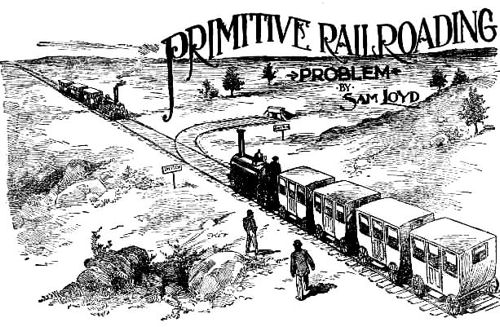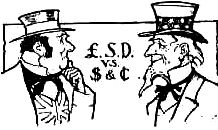



OWING TO THE WIDESPREAD interest taken in a simple little Rail Road Switch Problem which I sprung upon my friends some time ago, as well as in response to the request from many for another practical lesson in railroading, I present one which is an offshoot from the first, and illustrates the difference, between sidetracking a train or passing it through a Y branch, which reverses the direction of the trains. In this specimen of primitive railroading we have an engine and four cars meeting an engine with three cars, and the problem, as in the previous one, is to ascertain the most expeditious way of passing the two trains by means of the switch or side-track, which is only large enough to hold one engine or one car at a time. No ropes, poles or flying switches are to be used, and it is understood that a car cannot be connected to the front of an engine. It shows the primitive way of passing trains before the advent of modem methods, and the puzzle is to tell just how many times it is necessary to back or reverse the directions of the engines to accomplish the feat, each reversal of an engine being counted as a move in the solution.
1. Back the R engine far out to the right.
2. Run the R engine on to switch.
3. Run L engine with three cars out to the right.
4. R engine back to the main track.
5. R engine out to the left, with three cars to left of switch.
6. L engine on to switch.
7. R engine and cars to right.
8. R engine pulls seven cars to left,
9. L engine runs to main track.
10. L engine backs to train.
11. L engine pulls five cars to right of switch.
12. L engine backs rear car on to switch.
13. L engine draws four cars to right.
14. L engine backs four cars to left.
15. L engine goes alone to right.
16. L engine backs to switch.
17. L engine pulls car from switch to track.
18. L engine backs to left.
19. L engine goes forward with six cars.
20. L engine backs rear car on to switch.
21. L engine goes to right with five cars.
22. L engine backs five cars to left.
23. L engine goes to right with one car.
24. L engine backs to switch.
25. L engine goes to right with two cars,
26. L engine backs to left of switch.
27. L engine draws seven cars to right of switch.
28. L engine backs end car on to switch.
29. L car goes to right.
30. R train backs to right.
31. R train picks up its four cars and skips.
32. L train backs to switch.
33. L train picks up its third cat and goes on its way rejoicing.
2. Pounds, Shillings and Pence Mixed With Dollars and Sense.

An advocate of our decimal system of currency refers to the well understood feature that the removal of the decimal point does not change the value of the sum-total of a given sum of money. For example, take $90.16.2, which represents ninety dollars, sixteen cents and two mills, and remove all the decimal points, and we have 90,162 mills, which does not change the value. When the writer, however, says that this cannot be done with English money he errs, and we invite him, as well as our army of puzzlists, to solve the following:
Find a certain sum of English money, in pounds, shillings and pence, the value of which will not be changed by the removal of the separating dots.
[There are 20 s./£ (shillings per pound) and 12 d./s. (pence per shilling). - jws]
3. Dollars and Sense Puzzle.
Here is another problem on what we might term similar dissimilar lines, which goes to prove that the Yankee dollars are just as smart as the English pounds. A puzzling financier discovered that any number of £, s., d., reversed and subtracted will always produce 19s. 11d. or a multiple thereof [See note in previous problem for currency conversion. - jws]. For example, take any amount below ten pounds, say:
£ s. d.
9 6 8
Reversed 8 6 9
-------
19 11
Or again 8 6 2
2 6 8
-------
5 19 6
which is six times 19s 11d.
The interesting feature of the puzzle is the statement that “no one has been able to explain this curious relationship of pounds, shillings and pence!”
Cannot some of our clever puzzlists give the why and wherefore of this curious action of the English money, by showing by means of an example that the same phenomenon applies to our own United States currency as well?
U. S. A. money can be treated the same as English money, for if you take any row of figures and reverse them and deduct the smaller from the greater it will leave 9 or a multiple of 9, viz.:
$8.57 9.31 4321
7.58 1.39 1234
---- ---- ----
.99 7.92 3087
[Page 89]